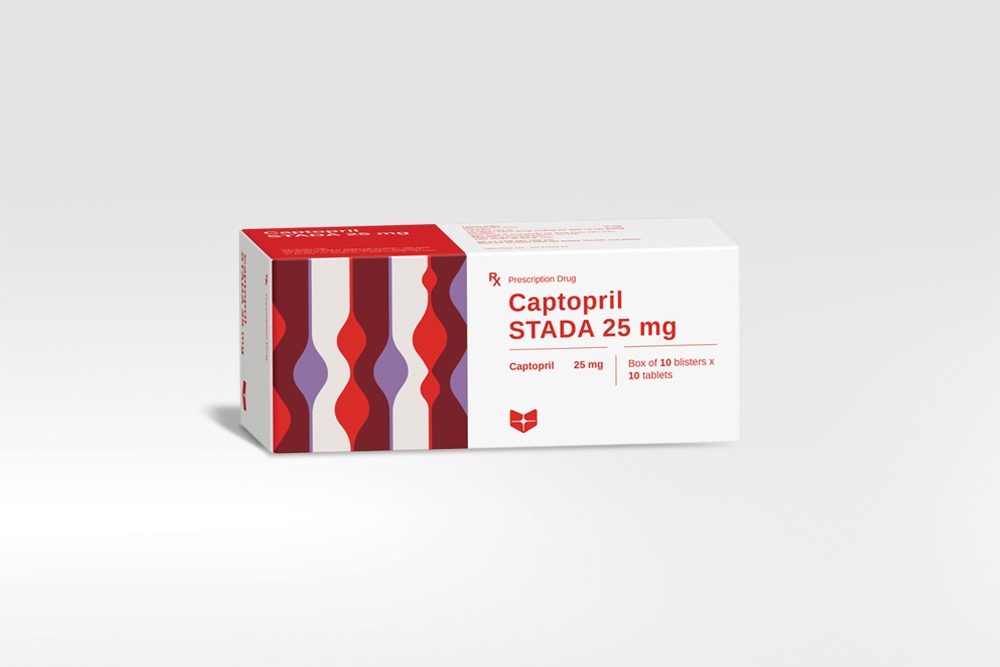Indications
– Hypertension.
– Congestive heart failure.
– Type I diabetic nephropathy.
– Myocardial infarction.
- Short-term (4 weeks) treatment: Captopril is indicated in any clinically stable patient within the first 24 hours of an infarction.
- Long-term prevention of symptomatic heart failure: Captopril is indicated in clinically stable patients with asymptomatic left ventricular dysfunction (ejection fraction ≤ 40%) following myocardial infarction to improve survival.
Dosage
Hypertension: Start with 25-50 mg daily in two divided doses. The dose may be increased incrementally, with intervals of at least 2 weeks, to 100-150 mg/day in two divided doses as needed to reach target blood pressure.
Patients with a strongly active renin-angiotensin-aldosterone system (hypovolaemia, renovascular hypertension, cardiac decompensation) commence with a single dose of 6.25 mg or 12.5 mg. These doses will then be used at a rate of two per day. The dosage can be gradually increased to 50 mg per day in one or two doses, if necessary to 100 mg per day in one or two doses.
Congestive heart failure: Start with 6.25 mg – 12.5 mg BID or TID. Titration to the maintenance dose should be carried out based on patient’s response, clinical status and tolerability, up to a maximum of 150 mg per day in divided doses. The dose should be increased incrementally, with intervals of at least 2 weeks to evaluate patient’s response.
Myocardial infarction:
- Short-term treatment: Treatment should begin in hospital as soon as possible. A 6.25 mg test dose should be administered, with a 12.5 mg dose being administered 2 hours afterwards and a 25 mg dose 12 hours later. From the following day, use dose of 100 mg/day, in two daily administrations, for 4 weeks, if warranted by the absence of adverse haemodynamic reactions. At the end of the 4 weeks of treatment, the patient’s state should be reassessed before a decision is taken concerning treatment for the post-myocardial infarction stage.
- Chronic treatment: If captopril treatment has not begun during the first 24 hours of the acute myocardial infarction stage, it is suggested that treatment be instigated between the 3rd and 16th day post-infarction once stable haemodynamics and management of any residual ischaemia have been attained. Initiate with a dose of 6.25 mg followed by 12.5 mg 3 times daily for 2 days and then 25 mg 3 times daily if warranted by the absence of adverse haemodynamic reactions. The recommended dose for effective cardio protection during long-term treatment is 75 to 150 mg daily in two or three doses.
Type I diabetic nephropathy: The recommended dose is 75 – 100 mg daily in divided doses.
Patients with renal impairment: The following daily dose may be recommended:
|
Creatinine clearance
(ml/min/1.73 m2)
|
Daily starting dose (mg) |
Daily maximum dose (mg)
|
|
> 40
|
25 – 50 |
150
|
|
21 – 40
|
25 |
100
|
|
10 – 20
|
12,5 |
75
|
| < 10 |
6,25 |
37,5
|
Elderly: Initiate with 6.25 mg BID.
Children and adolescents: Children > 20 kg: Start with 0.3 mg per kg body weight. Captopril is administered to children 3 times a day, but dose and interval of dose should be adapted individually according to patient’s response.
Usage
Captopril STELLA 25 mg is administered orally, may be taken before, during and after meals.
















